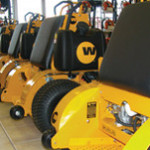Why a Bigger Mower is not Always Better
It's difficult for many lawn maintenance professionals who have large jobs to resist the temptation of aircraft carrier-sized mowers. Bigger, wider, and larger equals getting those jobs done faster, right? But unless you're mowing acres of grass uninterrupted by slopes, closely spaced obstacles, culverts, etc., you're more likely to get the job done sooner, and with better results, by employing a smaller and more maneuverable machine.
Few lawn areas, commercial or residential, are perfectly flat. Dealing with hills, inclines, and sudden dips are all part of virtually every job. The problem with using King Kong mowers is that they can cause gouging, scalping, or uneven cutting on troughs or drainage channels, even shallow ones. Often there just isn't enough room for the deck of a large mower to reach into the lowest part of a culvert—and then you have to bring in a smaller mower to take care of it, adding more time to the job.
Speaking of limited room, perhaps the most challenging obstacles on a job are trees, shrubs, walls, signs, light posts, fencing, etc. that are only a few feet apart. Again, a large mower often has to wave the white flag in these instances. A smaller machine with a Stand-on design can handle tight spaces and enable the operator to maintain control while shifting his position to avoid low branches.
Another area where space is in short supply is on your trailers. The more space a large mower takes up, the less there is for, well, anything else that can help you on the job. No matter how you cut it, one big mower will always be less efficient than two small or mid-sized mowers.
Finally, one thing that big mowers bring to every job is big weight. Lawns that have been softened by overnight rains or even watering from sprinkler systems can't stand up to 1,200 lb. mowers without some sort of damage. Sure, the grass is mowed—but you've also created ruts and ridges in the soil that the client won't be happy about. The business won't be staying with you long if you're creating new eyesores.
While mega-sized mowers have their place, the vast majority of jobs can be handled more efficiently and with better quality by a small to mid-sized machine. And a stand-on mower allows you to push productivity even further by being able to handle an entire job, which usually includes navigating obstacles and challenging terrain, all by itself. If you want to think big, it's better to orient your thinking around maximizing productivity rather than the size of your cutting decks.


